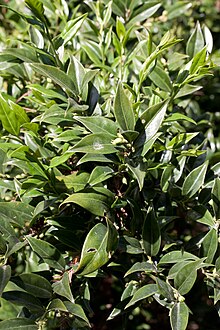Sarcococca confusa
| Sarcococca confusa | |
|---|---|

| |
| Scientific classification | |
| Kingdom: | Plantae |
| Clade: | Tracheophytes |
| Clade: | Angiosperms |
| Clade: | Eudicots |
| Order: | Buxales |
| Family: | Buxaceae |
| Genus: | Sarcococca |
| Species: | S. confusa
|
| Binomial name | |
| Sarcococca confusa | |
Sarcococca confusa, the sweet box, is a species of flowering plant in the family Buxaceae, probably native to western China. It is an evergreen shrub growing to 2 m (7 ft) tall by 1 m (3 ft) broad, with glossy green ovate leaves and honey-scented[1] white flowers in winter, followed by glossy black spherical fruits, 5 mm in diameter.[2]
It is a very adaptable and reliable shrub that is easily grown in many situations, including dense shade with very dry soil. It will however grow in full sun, even though the foliage appears to bleach a little. The soil should be kept damp if grown in sun or part shade. The shrub is midwinter flowering with a sweet scent. The small black berries are eaten by birds which disperse the seeds.[3]
The genus Sarcococca is widely distributed in southeast Asia from Afghanistan through the Himalaya to SE Tibet, Assam, Upper Burma and China, southwards in peninsula India, Sri Lanka, Thailand, Indochina, to Java and Sumatra, Taiwan and Luzon.[4][5] This plant has gained the Royal Horticultural Society's Award of Garden Merit.[6][7]
Description[]
Sarcococca confusa is a very adaptable and reliable shrub that is easily grown in many situations, including dense shade with very dry soil. It will however grow in full sun, even though the [foliage appears to bleach a little. The soil should be kept damp if grown in sun or part shade. The shrub is midwinter flowering with a sweet scent. The small black berries are eaten by birds which disperse the seeds.[8] It is an evergreen shrub growing to 2 m (7 ft) tall by 1 m (3 ft) broad, with glossy green ovate leaves and honey-scented [9] white flowers in winter, followed by glossy black spherical fruits, 5 mm in diameter.[10]
References[]
- ^ "Cambridge University Botanic Garden - Sarcocca confusa". Retrieved 2 June 2013.
- ^ RHS A-Z encyclopedia of garden plants. United Kingdom: Dorling Kindersley. 2008. p. 1136. ISBN 1405332964.
- ^ Keen, Mary (January 5, 2002). "How to grow: Sarcococcas" – via www.telegraph.co.uk.
- ^ Hoskins, T., & Contreras, R. N. (2019, November 1). Exposing seeds of Sarcococca confusa to increased concentrations and durations of ethyl methanesulfonate reduced seed germination, twinning, and plant size. hortsci. Retrieved December 22, 2021, from https://journals.ashs.org/hortsci/view/journals/hortsci/54/11/article-p1902.xml
- ^ J. ROBERT SEALY, A revision of the genus Sarcococca (Buxaceae), Botanical Journal of the Linnean Society, Volume 92, Issue 2, February 1986, Pages 117–159, https://doi.org/10.1111/j.1095-8339.1986.tb01828.x
- ^ "RHS Plant Selector - Sarcococca confusa". Retrieved 5 March 2021.
- ^ "AGM Plants - Ornamental" (PDF). Royal Horticultural Society. July 2017. p. 95. Retrieved 30 October 2018.
- ^ Telegraph Media Group. (2002, January 5). How to grow: Sarcococcas. The Telegraph. Retrieved December 22, 2021, from https://www.telegraph.co.uk/gardening/howtogrow/3296342/How-to-grow-Sarcococcas.html
- ^ Garden Map. Cambridge Botanic Garden. (2021, September 9). Retrieved December 22, 2021, from https://www.botanic.cam.ac.uk/the-garden/garden-map/
- ^ RHS A-Z encyclopedia of garden plants. United Kingdom: Dorling Kindersley. 2008. p. 1136. ISBN 1405332964.
- Sarcococca
- Flora of China
- Plants described in 1949